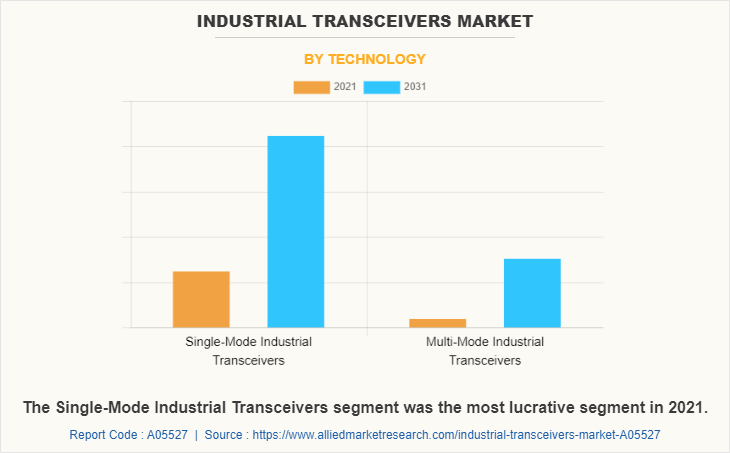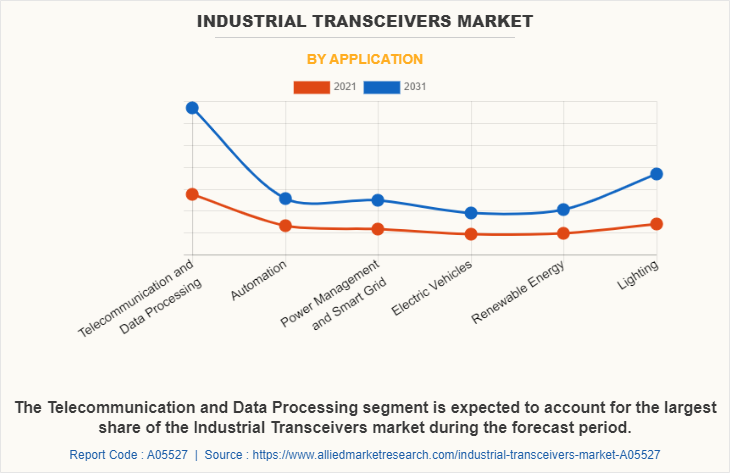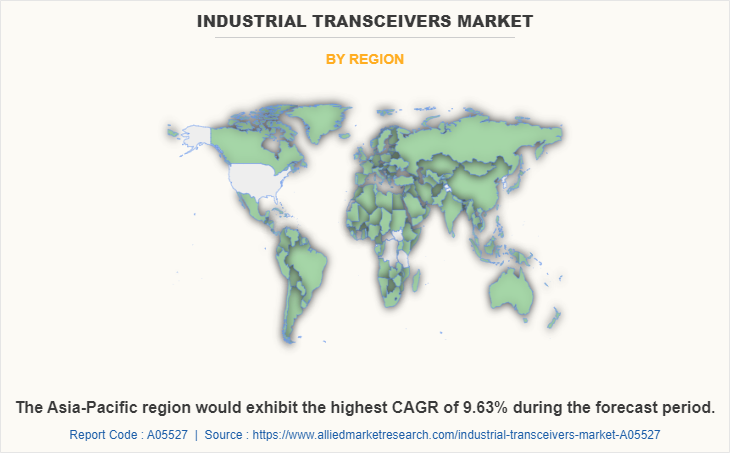Industrial Transceivers Market Research, 2031
The global industrial transceivers market was valued at $1.7 billion in 2021 and is projected to reach $3.9 billion by 2031, growing at a CAGR of 8.8% from 2022 to 2031.
A transceiver is a device that can both transmit and receive signals. It combines the functions of a transmitter and a receiver into a single unit. Transceivers are commonly used in telecommunications, radio communication, and networking applications. Industrial transceivers are transceivers designed for use in industrial settings and applications. These types of transceivers are often designed to withstand harsh environmental conditions, including extreme temperature, dust, moisture, and vibration.

The industrial transceivers market has grown steadily in recent years, driven by a surge in demand for reliable and efficient communication in industrial settings. Industrial transceivers are designed for use in harsh environments and are commonly used in industrial control systems, automation equipment, and other industrial applications. They are an essential component of modern industrial communication systems, enabling the transmission of control signals and data between devices and systems.
Segment Overview
The industrial transceivers market is segmented into Technology and Application.
By technology, the market is bifurcated into single-mode industrial transceivers and multi-mode industrial transceivers. The single-mode technology segment is the largest and fastest-growing segment of the industrial transceivers market.

By application, the market is categorized into automation, telecommunication & data processing, lighting, electric vehicles, power management & smart grid, and renewable energy. According to industrial transceivers market growth, the lighting application segment is the fastest growing segment.

Region-wise, the industrial transceivers market trends are analyzed across North America (the U.S., Canada, and Mexico), Europe (UK, Germany, France, and the rest of Europe), Asia-Pacific China, Japan, India, South Korea, and the rest of Asia-Pacific), and LAMEA (Latin America, the Middle East, and Africa). Asia-Pacific, specifically the China region, remains a significant participant in the global industrial transceivers industry.

Country Analysis
Country-wise, the U.S. acquired a prime share in the industrial transceivers market in the North American region and is expected to grow at a significant CAGR during the forecast period of 2019-2031. The U.S., holds a dominant position in the industrial transceivers market size, owing to the rise in investment by prime vendors to boost the industrial transceivers for consumer electronics and IT & telecom applications.
In Europe, the UK, dominated the industrial transceivers market share, in terms of revenue, in 2021 and is expected to follow the same trend during the forecast period. Germany is expected to emerge as the fastest-growing country in Europe's industrial transceivers with a notable CAGR, due to advancement in the automotive industry which drives the usage of microelectronics in the country and thus creates lucrative opportunities for the industrial transceivers market growth in Germany.
In Asia-Pacific, China is expected to emerge as a significant market for the industrial transceivers industry, owing to new product developments and a significant rise in investment by prime players and government institutions. The well-established electronics industry in the Asia-Pacific region and the adoption of innovative technologies have given organizations in the region a competitive edge in the market.
In the LAMEA region, Middle East countries garner significant market share in 2021 due to the adoption of new technologies, digital transformation, and connectivity are reshaping the future of the automotive and consumer electronics industry in the Middle East. Moreover, the Latin America region is expected to grow at a significant CAGR from 2022 to 2031, owing to shifts in artificial intelligence, industry 4.0, and smart technological changes in recent years, which is expected to reshape the growth of the industrial transceivers in the Latin America region.
Industrial transceivers can operate using a variety of different transmission technologies, including wired and wireless options. Some examples of industrial transceivers include Ethernet transceivers, RS-485 transceivers, and wireless transceivers such as ZigBee, LoRa, and cellular transceivers. In addition to their rugged design and reliable performance, industrial transceivers often include features such as diagnostic capabilities and error detection & correction mechanisms to ensure the reliable transmission of data in industrial environments.
The Industrial Transceivers Market Outlook suggests a positive growth trajectory in the coming years, growth in the use of wireless communication systems, increased process innovations, lower manufacturing costs, and a surge in industrial automation are some of the major factors driving the demand for the industrial transceiver market during the forecast period. However, the growth of the industrial transceiver market may be hindered by rapidly changing network and communication technologies, as well as the development and use of next-generation technologies. In addition, the wide range of applications of industrial transceivers such as motor control & drives, renewable energy, electric vehicles, smart grid, and lighting, automation is expected to accelerate the growth of the industrial transceiver market.
Top Impacting Factors
The industrial transceiver market is being propelled by several factors, including the surge in the importance of the Internet and the growth in demand for the Industrial Internet of Things (IIoT), as well as the adoption of cloud computing, data storage, and transmission. Furthermore, the rising usage of automation and robotics in the manufacturing industry for efficient and dependable communication between various machines and devices is another crucial factor contributing to the growth of the industrial transceiver market. Despite these drivers, the high implementation cost and lack of standardized communication protocols associated with industrial transceivers present significant market barriers. However, the emergence of 5G technology provides a significant opportunity for the industrial transceiver market to expand and flourish, as 5G offers faster and more dependable wireless communication, leading to promising growth prospects for the industrial transceiver market.
Competitive Analysis
The global industrial transceivers market is highly competitive, owing to the strong presence of existing vendors. Vendors of the industrial transceivers market with extensive technical and financial resources are expected to gain a competitive advantage over their competitors because they can cater to market demands. The competitive environment in this market is expected to increase as product launches and different strategies adopted by key vendors increase. Competitive analysis and profiles of the major global industrial transceivers market players that have been provided in the report include Finisar Corporation, Cisco Systems Inc., Analog Devices Inc., Renesas Electronics, AMS Technologies AG, CTC Union Technologies Co., Ltd., Fujitsu Ltd., Eaton Corporation, Senra Tech, and Infineon Technologies.
Key Developments/ Strategies
According to the latest industrial transceivers market forecast, the top 5 key players in the industrial transceivers market are Cisco Systems Inc., Fujitsu Ltd., Eaton Corporation, Analog Devices Inc., and Finisar Corporation. Top market players have adopted various strategies, such as product launch, collaboration, innovation, acquisition, and others to expand their foothold in the industrial transceivers market.
In March 2022, STL, an industry-leading integrator of digital networks, made a collaboration with Analog Devices, Inc. to develop 5G Open RAN radio units (O-RU). Together, the two companies have built 5G-ready solutions to expand the diversity of commercially available O-RUs and facilitate the growth of Open RAN networks. As a part of this collaboration, STL and Analog Devices will work closely with other ecosystem providers, including leading power amplifier (PA) vendors, to expand the range of STL's Garuda O-RU indoor small cell offerings. STL integrated Analog Devices' leading RadioVerse transceivers into Garuda to create power-efficient, high-performance radios.
In June 2022, Fujitsu Optical Components Limited launched a bidirectional 100G QSFP28 BiDi Optical Transceiver that can achieve high throughput capacity and reduce the operating costs of mobile and access networks.
In October 2022, Cisco launched an innovation across its Nexus 9000 and Cisco 8000 portfolios designed to help enterprise, webscale, and hyperscale customers meet sustainability goals. New routers and switches powered by Cisco Silicon One, and new high-density optical transceivers all capable of supporting 800G help to redefine the economics of the cloud and boost network performance, while improving sustainability and connectivity needs for cloud services.
Key Benefits for Stakeholders
- This report provides a quantitative analysis of the market segments, current trends, estimations, and dynamics of the industrial transceivers market analysis from 2021 to 2031 to identify the prevailing industrial transceivers market opportunity.
- The market research is offered along with information related to key drivers, restraints, and opportunities.
- Porter's five forces analysis highlights the potency of buyers and suppliers to enable stakeholders to make profit-oriented business decisions and strengthen their supplier-buyer network.
- An in-depth analysis of the industrial transceivers market segmentation assists in determining the prevailing market opportunities.
- Major countries in each region are mapped according to their revenue contribution to the global market.
- Market player positioning facilitates benchmarking and provides a clear understanding of the present position of the market players.
- The report includes an analysis of the regional as well as global industrial transceivers market trends, key players, market segments, application areas, and market growth strategies.
Industrial Transceivers Market Report Highlights
| Aspects | Details |
| Market Size By 2031 | USD 3.9 billion |
| Growth Rate | CAGR of 8.8% |
| Forecast period | 2021 - 2031 |
| Report Pages | 326 |
| By Technology |
|
| By Application |
|
| By Region |
|
| Key Market Players | Finisar Corporation, Renesas Electronics, Eaton Corporation, Infineon Technologies, Senra Tech, ams technologies ag, Fujitsu Ltd., Analog Devices Inc., CTC Union Technologies Co.,Ltd, Cisco Systems Inc. |
Analyst Review
The market for industrial transceivers is expected to experience significant growth in the coming years due to factors such as the increasing demand for automation in industrial processes, the rise of Industrial Internet of Things (IIoT), and the need for efficient & reliable communication in harsh industrial environments.
One of the major trends in the industrial transceiver market is the increasing adoption of wireless communication technologies, such as Bluetooth, ZigBee, and Wi-Fi. These wireless technologies allow greater flexibility and mobility in industrial settings, while also reducing the cost and complexity of traditional wired communication systems.
The Industrial Transceivers Market is expected to grow at a CAGR of 8.78% from 2022-2031.
The Telecommunication and data processing segment is the leading application segment of Industrial Transceivers Market.
Asia-Pacific is the largest regional market for Industrial Transceivers.
The industry size of Industrial Transceivers is estimated to be $1,710.4 million in 2021.
The top companies to hold the market share in Industrial Transceivers Market are Cisco Systems Inc., Fujitsu Ltd., Eaton Corporation, Analog Devices Inc., and Finisar Corporation.
Loading Table Of Content...



